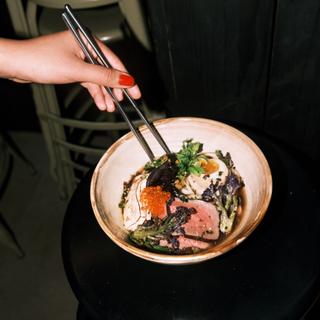


Subtle, satisfying and cheap: Ramen is a slurpable phenomenon
Feature'Influential Japanese cuisine' (3/6). This simmering emblem of Japanese gastronomy has spread far beyond its borders. Now, with heads over their bowls, everyone slurps and says 'ramen' in all its forms, even in the land of the pot-roast chicken!
In his 1985 film Tampopo, Japanese director Juzo Itami tells the epic story of a chef trying to learn how to make the best ramen in Tokyo. The comedy opens with a restaurant scene: An aesthete who has spent 40 years studying noodle soups initiates his disciple into the art of tasting. To fully appreciate them, the old man advises against diving in immediately; instead, he suggests taking time to examine the bowl, the fat droplets floating on the broth, the gleam of the bamboo shoots, the nori seaweed, the proudly floating onions and, above all, the magnificent slices of roast pork, the stars of the dish. Then, with the tips of his chopsticks, he lovingly caresses the ingredients. Only after several minutes of contemplation does he taste the noodles, staring intently at the meat, as if to let it know he hasn't forgotten it.
This scene playfully illustrates the Japanese all-consuming passion for ramen. The specialty is so popular that it even has its own attraction: the Ramen Museum, located in Shin-Yokohama, an hour's drive south of Tokyo (imagine a French museum devoted to the ham-and-butter baguette!). The setting is a stunning reconstruction of the streets of the Japanese capital in 1958, the year instant noodles were invented.
This vintage backdrop, filled with movie posters, toys and vehicles from the past, is home to many real ramen restaurants, as well as educational areas. It is here that visitors discover that the Japanese specialty actually has Chinese origins. When the country put an end to a long period of isolation in 1868, at the start of the Meiji era, foreign dishes gradually blended with Japanese ones. Wheat noodles from neighboring China were combined with local delicacies such as dashi (clear broth) and narutomaki (fish pâté in the shape of a white disk encrusted with a pink spiral), giving rise to the first versions of ramen.

Today, there are almost as many types of noodle soup as there are Japanese cities. Although ramen always includes broth, noodles and toppings, each of these elements can vary. In Tokyo, the brown, salty soup is generally made with soy sauce. In Sapporo (to the north), it's a little lighter, made with miso paste (fermented soybeans). In Fukuoka (south), it's thick and creamy, with pork bones boiled for a long time in the broth. Noodles can be straight or wavy, varying in thickness depending on the region. As for the protein, while pork slices are common, they can be substituted with ground beef or seafood.
In a sign of the times, several stalls now offer versatile dishes tailored to religious practices (halal ramen) or dietary preferences. Vegan versions are popping up, like those at T's Tantan, a small chain that relies on sesame, beans and mushrooms to create a dish that's just as tasty as it is filling.
You have 60.34% of this article left to read. The rest is for subscribers only.
